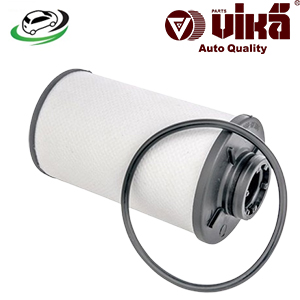-9%
Get Transmission Oil Filter Audi 8V S3/ A3 8P/ A3 8V/ MK3 TT (2014+)/ TT MKI/ TTS / VW Beetle/ Alltrack/ EOS/ Golf V/ Golf VII/ Passat B6 02E398051
The transmission oil filter is a crucial component in the overall health and longevity of an automatic transmission system. Much like the engine oil filter is essential for keeping the engine’s oil clean, the transmission oil filter serves the same purpose for the transmission fluid. It ensures that the fluid, which lubricates and cools the transmission’s moving parts, remains free from contaminants that could cause wear and damage.
The Role of the Transmission Oil Filter
The transmission oil filter is designed to remove dirt, metal shavings, and other debris from the transmission fluid before it circulates through the transmission. Automatic transmission fluid (ATF) is a vital lubricant, coolant, and hydraulic fluid, enabling the transmission to shift gears smoothly. Over time, as the transmission operates, small particles from wear and tear, as well as contaminants from outside sources, can mix with the fluid. If these particles aren’t filtered out, they can lead to increased friction, overheating, and eventually, severe damage to the transmission.
The filter is usually made from a mesh material, sometimes combined with a paper element, which captures these particles. In some designs, the filter also has a magnet that helps to attract and trap metallic particles, providing an additional layer of protection.
Types of Transmission Oil Filters
Transmission oil filters come in various types and designs, depending on the make and model of the vehicle. The most common types include:
- Conventional Filters: These are often found in the transmission pan and are the most common type of transmission oil filter. They are generally made of a paper or fiber material that traps contaminants as the fluid passes through.
- Spin-On Filters: Similar to engine oil filters, these can be screwed on and off, making them easier to replace. They are often found in older vehicles and some heavy-duty applications.
- Magnetic Filters: These are integrated with a magnet to capture and hold metallic particles. The magnet provides additional protection by trapping metal shavings that might otherwise pass through the filter material.
- Inline Filters: These are placed within the transmission’s fluid lines and can be added as an aftermarket accessory. They are especially useful in high-performance or heavy-duty vehicles where additional filtration is beneficial.
Benefits of a Clean Transmission Oil Filter
Keeping the transmission oil filter clean and in good condition is essential for the overall performance and longevity of the transmission. Some of the key benefits include:
- Extended Transmission Life: By filtering out harmful particles, the transmission oil filter helps to prevent damage to the transmission’s internal components. This reduces wear and tear, extending the transmission’s lifespan.
- Improved Shifting Performance: Clean fluid allows for smoother operation of the transmission’s hydraulic system, leading to more consistent and smoother gear shifts.
- Reduced Risk of Overheating: Contaminants in the transmission fluid can cause the transmission to work harder, leading to increased friction and heat. A clean filter ensures that the fluid flows freely and efficiently, helping to keep the transmission cool.
- Cost Savings: Regularly replacing the transmission oil filter can help to avoid costly repairs. A damaged transmission often requires expensive repairs or even a full replacement, which can be far more costly than routine maintenance.
Signs of a Clogged or Dirty Transmission Oil Filter
Recognizing the signs of a clogged or dirty transmission oil filter is important to avoid potential transmission damage. Some common symptoms include:
- Slipping Gears: If the transmission is slipping out of gear or struggling to stay in gear, it could be a sign that the fluid isn’t flowing properly due to a clogged filter.
- Rough or Delayed Shifting: A dirty filter can restrict fluid flow, causing delays or roughness when shifting gears.
- Transmission Overheating: If the transmission is running hotter than normal, it might be due to restricted fluid flow caused by a clogged filter. Overheating can lead to serious damage if not addressed promptly.
- Unusual Noises: Whining or grinding noises from the transmission can indicate that the fluid isn’t lubricating the components properly, potentially due to a blocked filter.
- Leaking Fluid: In some cases, a clogged filter can cause pressure to build up in the transmission, leading to fluid leaks.
Replacing the Transmission Oil Filter
Replacing the transmission oil filter is a task that should be performed at regular intervals as part of routine vehicle maintenance. The frequency of replacement can vary depending on the vehicle, driving conditions, and the type of transmission fluid used. Typically, it is recommended to replace the filter every 30,000 to 60,000 miles.
Here’s a general overview of the steps involved in replacing a transmission oil filter:
- Drain the Transmission Fluid: Before replacing the filter, the old transmission fluid needs to be drained. This usually involves removing the transmission pan, which allows the fluid to drain out.
- Remove the Old Filter: Once the fluid is drained, the old filter can be accessed and removed. It may be held in place by bolts, clips, or simply friction-fitted.
- Install the New Filter: After removing the old filter, the new one is installed in its place. It’s important to ensure that it is securely in place and properly aligned.
- Replace the Transmission Pan Gasket: If the transmission pan was removed, it’s also a good idea to replace the gasket to prevent leaks when reassembling.
- Refill with Fresh Transmission Fluid: Finally, the transmission is refilled with the appropriate type and amount of fresh fluid. It’s crucial to use the correct fluid type specified by the vehicle manufacturer.
Follow us on Facebook for more parts.



